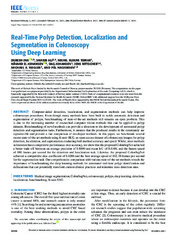Blar i forfatter "Tomar, Nikhil Kumar"
-
Assessing generalisability of deep learning-based polyp detection and segmentation methods through a computer vision challenge
Ali, Sharib; Ghatwary, Noha; Jha, Debesh; Isik-Polat, Ece; Polat, Gorkem; Yang, Cheng; Li, Wuyang; Galdran, Adrian; Ballester, Miguel Angel Gonzalez; Thambawita, Vajira L B; Hicks, Steven; Poudel, Sahadev; Lee, Sang-Woong; Jin, Ziyi; Gan, Tianyuan; Yu, Chenghui; Yan, JiangPeng; Yeo, Doyeob; Lee, Hyunseok Lee; Tomar, Nikhil Kumar; Haitham, Mahmood; Ahmed, Amr; Riegler, Michael Alexander; Daul, Christian; Halvorsen, Pål; Rittscher, Jens; Salem, Osama E.; Lamarque, Dominique; Cannizzaro, Renato; Realdon, Stefano; de Lange, Thomas; East, James E (Journal article; Tidsskriftartikkel; Peer reviewed, 2024-01-23)Polyps are well-known cancer precursors identified by colonoscopy. However, variability in their size, appearance, and location makes the detection of polyps challenging. Moreover, colonoscopy surveillance and removal of polyps are highly operator-dependent procedures and occur in a highly complex organ topology. There exists a high missed detection rate and incomplete removal of colonic polyps. To ... -
Real-Time Polyp Detection, Localization and Segmentation in Colonoscopy Using Deep Learning
Jha, Debesh; Ali, Sharib; Tomar, Nikhil Kumar; Johansen, Håvard D.; Johansen, Dag; Rittscher, Jens; Riegler, Michael A.; Halvorsen, Pal (Journal article; Tidsskriftartikkel; Peer reviewed, 2021-03-04)Computer-aided detection, localization, and segmentation methods can help improve colonoscopy procedures. Even though many methods have been built to tackle automatic detection and segmentation of polyps, benchmarking of state-of-the-art methods still remains an open problem. This is due to the increasing number of researched computer vision methods that can be applied to polyp datasets. Benchmarking ... -
Real-Time Polyp Detection, Localization and Segmentation in Colonoscopy Using Deep Learning
Jha, Debesh; Ali, Sharib; Tomar, Nikhil Kumar; Johansen, Håvard D.; Johansen, Dag; Rittscher, Jens; Riegler, Michael; Halvorsen, Pål (Journal article; Tidsskriftartikkel; Peer reviewed, 2021-03-04)Computer-aided detection, localization, and segmentation methods can help improve colonoscopy procedures. Even though many methods have been built to tackle automatic detection and segmentation of polyps, benchmarking of state-of-the-art methods still remains an open problem. This is due to the increasing number of researched computer vision methods that can be applied to polyp datasets. ... -
Validating polyp and instrument segmentation methods in colonoscopy through Medico 2020 and MedAI 2021 Challenges
Jha, Debesh; Sharma, Vanshali; Banik, Debapriya; Bhattacharya, Debayan; Roy, Kaushiki; Hicks, Steven; Tomar, Nikhil Kumar; Thambawita, Vajira L B; Krenzer, Adrian; Ji, Ge-Peng; Poudel, Sahadev; Batchkala, George; Alam, Saruar; Ahmed, Awadelrahman M.A.; Trinh, Quoc-Huy; Khan, Zeshan; Nguyen, Tien-Phat; Shrestha, Shruti; Nathan, Sabari; Gwak, Jeonghwan Gwak; Jha, Ritika Kumari; Zhang, Zheyuan; Schlaefer, Alexander; Bhattacharjee, Debotosh; Bhuyan, M.K.; Das, Pradip K.; Fan, Deng-Ping; Parasa, Sravanthi; Ali, Sharib; Riegler, Michael Alexander; Halvorsen, Pål; de Lange, Thomas; Bagci, Ulas (Journal article; Tidsskriftartikkel; Peer reviewed, 2025-09-05)Automatic analysis of colonoscopy images has been an active field of research motivated by the importance of early detection of precancerous polyps. However, detecting polyps during the live examination can be challenging due to various factors such as variation of skills and experience among the endoscopists, lack of attentiveness, and fatigue leading to a high polyp miss-rate. Therefore, there is ...


 English
English norsk
norsk


